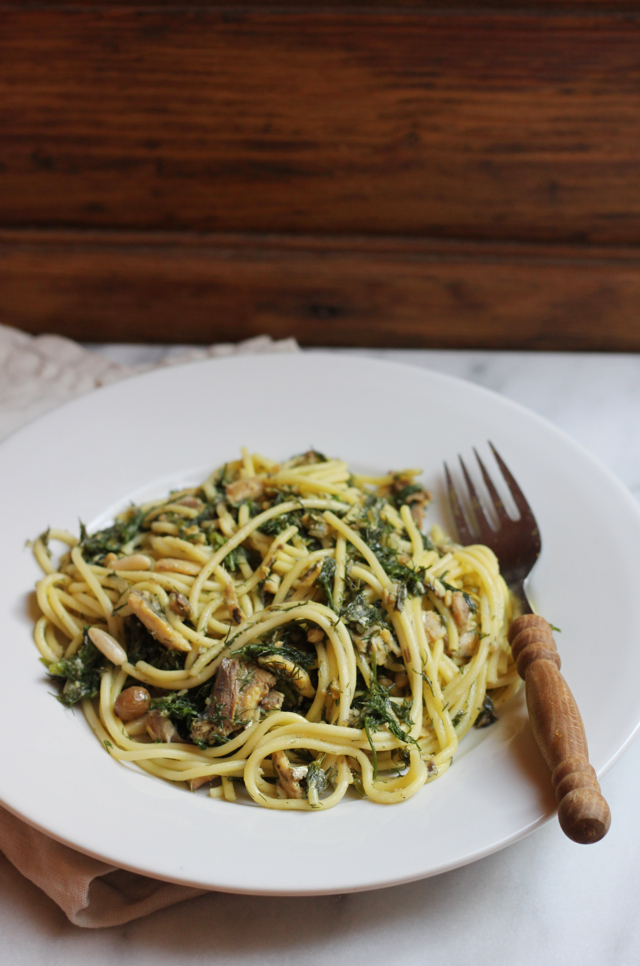While I love summer for its fruit, autumn for its earthy flavours and winter for hearty dishes, spring is my favourite time of year for vegetables – asparagus, broad beans, artichokes. And then there are the wild things – weeds, herbs and vegetables that grow spontaneously, filling up cracks in the pavement or taking over fields or overgrown garden corners.

Foraging for edible weeds and making food with wild vegetables is taking a step back in time. Gathering (as opposed to shopping) for your ingredients and making do with what you have is the basis of many traditional dishes all over Italy, but particularly in the centre-south where wild greens are well used in dishes that you could easily call real, proper peasant food, full of ancient flavours and satisfyingly free.
This classic, age-old Sicilian dish is a favourite. It’s no secret that I love sardines (if you do too, you might want to take a look at this post. Or this one. Oh, or this one). Not to mention foraging, especially for things like stinging nettle, wild garlic and wild chicory.

Pasta con le sarde is a seasonal dish, you’ll find it between March and September when freshly caught sardines are at their best and finocchietto, wild fennel, is abundant. It’s the finocchietto that really makes this dish. If it’s hard to come by, you could substitute regular fennel tops but you’ll want to try to find some at a farmers’ market where the tops are left on or grow your own as fennel is so often cut down just to the bulbs, you’ll be left with a tuft here or there but barely enough for this dish.
There are also several variations to this dish that you could also try. Fresh tomatoes could be added and a handful of toasted breadcrumbs sit very well dusted over the top before serving. Some add chopped almonds, some add saffron. I’ve made it with spaghetti but bucatini are also great.

Pasta con le sarde
Sardine and wild fennel pasta
Serves 4
- 400 grams of fresh sardines
- 250 grams of finocchietto (a huge bunch of wild fennel tops)
- 2 salted anchovies, rinsed of salt
- 2 small red onions (like Tropea), finely chopped
- 40 grams of pine nuts
- 40 grams of sultanas/raisins, softened in hot water
- saffron (optional)
- half a wineglass of white wine
- 320 grams of spaghetti or bucatini
- handful of breadcrumbs, toasted (optional)
Clean the sardine fillets by removing heads, tails, innards and dorsal fin, rinse and pat dry then chop roughly (see this post for a better idea). Blanch the wild fennel (hard stalks removed) in a large pot of salted water (keep this water for then cooking the pasta in). Simmer for about 10 minutes, remove the fennel with tongs, drain well and chop finely. Set aside.
In a skillet, heat some olive oil over low heat and cook the anchovies and onion until the anchovies melt down. Add the sardines, pine nuts and raisins (drained), stirring to brown the fish on all sides. If using the saffron, infuse it in a glass of hot water and when the water has taken on that golden colour, add it to the pan. Add the chopped fennel tops and the white wine and continue cooking.
Meanwhile, cook the spaghetti in the water where the fennel was cooked. When al dente, add it to the pan with the fennel tops and toss to combine. Serve with a handful of toasted breadcrumbs sprinkled on top, if desired.




Comments
I love your fork! (And that pasta looks amazing, obviously. )
Ha, thanks Angie! Picked that fork up in a tiny second hand shop in the countryside outside of Melbourne. Twas a good find!
Came across your blog whilst searching for a recipe for Pan di Ramerino (just got back from a trip to Florence and the bakery near our apartment had them – so good!). Just wanted to say I am loving all the recipes on this site – can’t wait to try them all! Have the chocolate pastry shell in the oven for your blackberry and mascarpone tart – can’t wait to try it! Keep up the good work x
Thank you Katie, glad you enjoyed your look around and your trip to Florence!
BEAUTIFUL post!Is it about sardines or about anchovies?They are not the same fish!
Elisabeth
Thanks Elisabeth – er, it’s all about sardines (no mention of anchovies and naturally, they are not the same fish!).
They are not the same fish, but they add a flavor that you can not leave out !!! They DO make a difference !!
Emiko, this dish is absolutely sensational! I love the idea of forging your own edible weeds and incorporating them into a lovely dish such as this. I look forward to making this even though I’ve never cooked with sardines. There’s a first time for everything! Thanks for the lovely post!
-Ashley
http://ashleydenaexo.blogspot.com/
The sultanas do a truly wonderful thing in this pasta. Thank you for sharing I have thoroughly enjoyed this recipe.
can you explain what semola is? is it semolina?
Semola and semolina is durum wheat that can be found ground into different sizes, leading to coarser and finer flours. One huge difference you’ll notice when looking at semola and semolina is it is yellower than regular wheat flour — the coarse version (semola) can even look a lot like polenta/cornmeal, while semolina is much finer, softer and paler. Semola is fantastic for making pasta and for dusting the bottom of pizza bases or bread loaves, while semolina can be used for making bread, pizza and even desserts or porridge. But you can’t substitute the two things for each other, they just won’t work!